Conflict Management and Leadership in Dream Home Project, Assessment 2
VerifiedAdded on 2022/10/10
|13
|3866
|385
Report
AI Summary
This report analyzes conflict management strategies and leadership styles within the context of building a dream home. It addresses potential conflicts with partners regarding design and inclusions, recommending a collaborative/problem-solving approach to reach consensus. The report also examines conflicts with the builder, outlining a multi-step process involving documentation, communication, and a calm, rational approach. Furthermore, it identifies transformational leadership as the preferred style for successful project management, emphasizing empowerment, intellectual stimulation, and individualized consideration to achieve project goals. The report provides a detailed examination of conflict management techniques for a construction project, covering various aspects of the project, including the selection of a suburb, risk management, partner collaboration, and builder interactions.
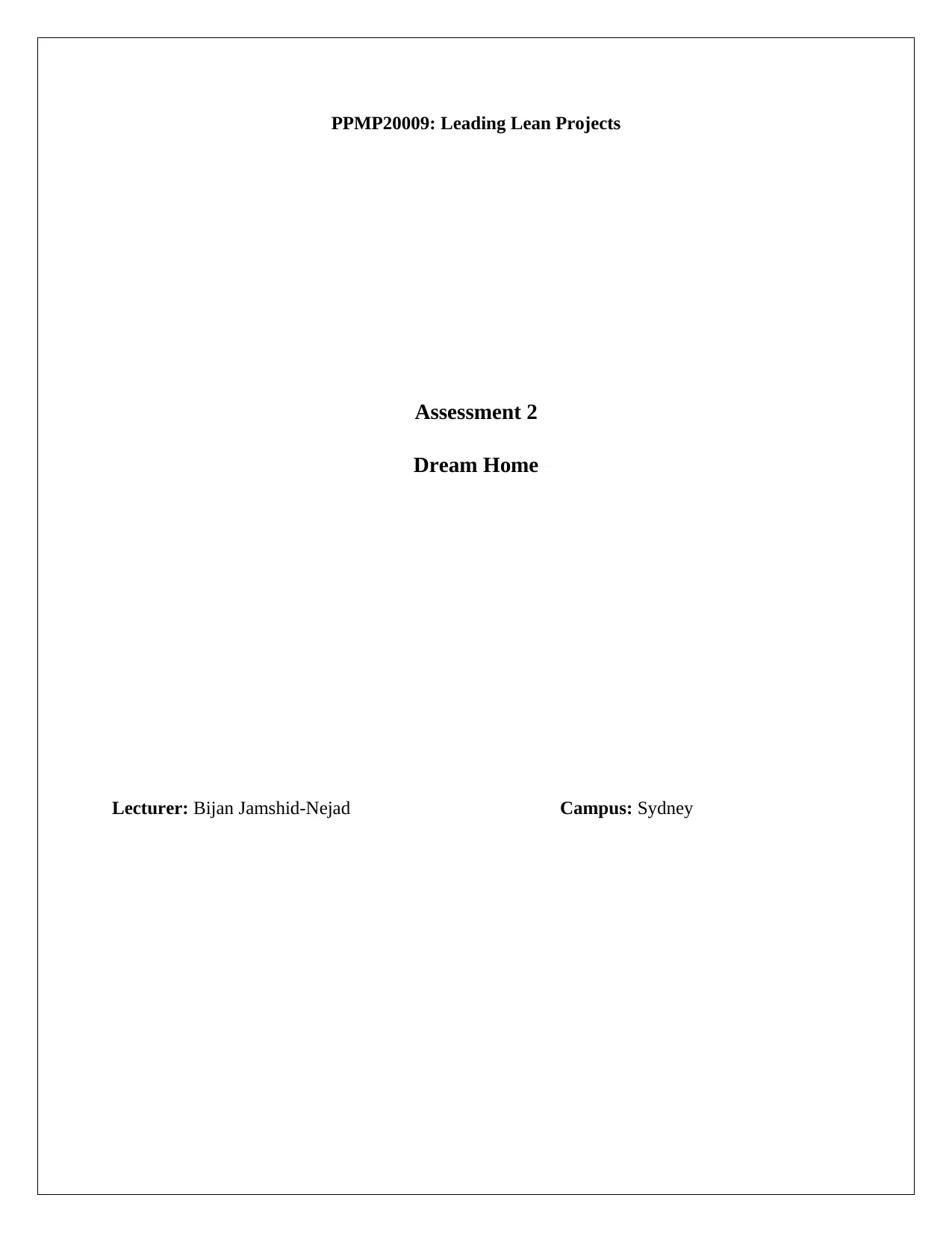
PPMP20009: Leading Lean Projects
Assessment 2
Dream Home
Lecturer: Bijan Jamshid-Nejad Campus: Sydney
Assessment 2
Dream Home
Lecturer: Bijan Jamshid-Nejad Campus: Sydney
Paraphrase This Document
Need a fresh take? Get an instant paraphrase of this document with our AI Paraphraser
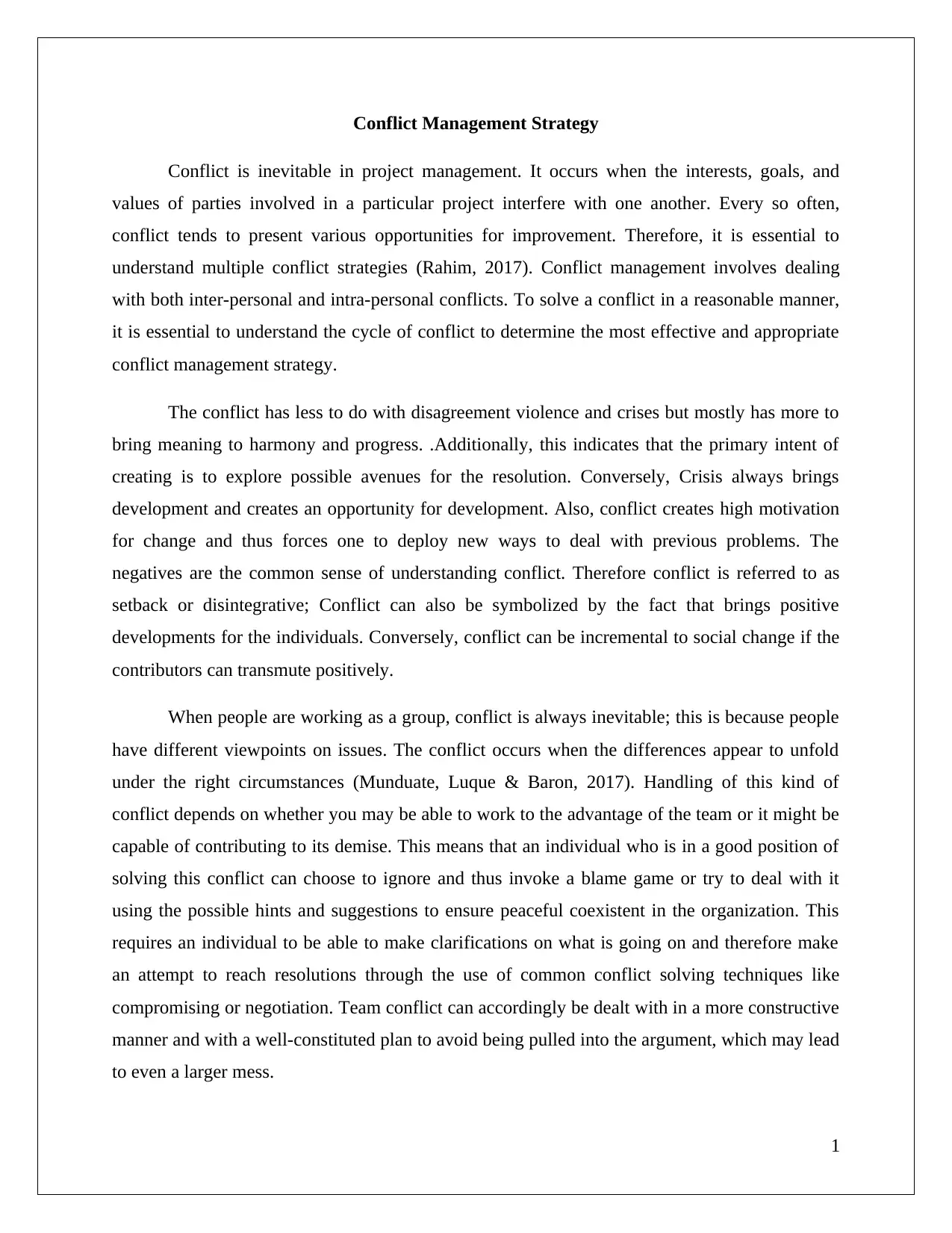
Conflict Management Strategy
Conflict is inevitable in project management. It occurs when the interests, goals, and
values of parties involved in a particular project interfere with one another. Every so often,
conflict tends to present various opportunities for improvement. Therefore, it is essential to
understand multiple conflict strategies (Rahim, 2017). Conflict management involves dealing
with both inter-personal and intra-personal conflicts. To solve a conflict in a reasonable manner,
it is essential to understand the cycle of conflict to determine the most effective and appropriate
conflict management strategy.
The conflict has less to do with disagreement violence and crises but mostly has more to
bring meaning to harmony and progress. .Additionally, this indicates that the primary intent of
creating is to explore possible avenues for the resolution. Conversely, Crisis always brings
development and creates an opportunity for development. Also, conflict creates high motivation
for change and thus forces one to deploy new ways to deal with previous problems. The
negatives are the common sense of understanding conflict. Therefore conflict is referred to as
setback or disintegrative; Conflict can also be symbolized by the fact that brings positive
developments for the individuals. Conversely, conflict can be incremental to social change if the
contributors can transmute positively.
When people are working as a group, conflict is always inevitable; this is because people
have different viewpoints on issues. The conflict occurs when the differences appear to unfold
under the right circumstances (Munduate, Luque & Baron, 2017). Handling of this kind of
conflict depends on whether you may be able to work to the advantage of the team or it might be
capable of contributing to its demise. This means that an individual who is in a good position of
solving this conflict can choose to ignore and thus invoke a blame game or try to deal with it
using the possible hints and suggestions to ensure peaceful coexistent in the organization. This
requires an individual to be able to make clarifications on what is going on and therefore make
an attempt to reach resolutions through the use of common conflict solving techniques like
compromising or negotiation. Team conflict can accordingly be dealt with in a more constructive
manner and with a well-constituted plan to avoid being pulled into the argument, which may lead
to even a larger mess.
1
Conflict is inevitable in project management. It occurs when the interests, goals, and
values of parties involved in a particular project interfere with one another. Every so often,
conflict tends to present various opportunities for improvement. Therefore, it is essential to
understand multiple conflict strategies (Rahim, 2017). Conflict management involves dealing
with both inter-personal and intra-personal conflicts. To solve a conflict in a reasonable manner,
it is essential to understand the cycle of conflict to determine the most effective and appropriate
conflict management strategy.
The conflict has less to do with disagreement violence and crises but mostly has more to
bring meaning to harmony and progress. .Additionally, this indicates that the primary intent of
creating is to explore possible avenues for the resolution. Conversely, Crisis always brings
development and creates an opportunity for development. Also, conflict creates high motivation
for change and thus forces one to deploy new ways to deal with previous problems. The
negatives are the common sense of understanding conflict. Therefore conflict is referred to as
setback or disintegrative; Conflict can also be symbolized by the fact that brings positive
developments for the individuals. Conversely, conflict can be incremental to social change if the
contributors can transmute positively.
When people are working as a group, conflict is always inevitable; this is because people
have different viewpoints on issues. The conflict occurs when the differences appear to unfold
under the right circumstances (Munduate, Luque & Baron, 2017). Handling of this kind of
conflict depends on whether you may be able to work to the advantage of the team or it might be
capable of contributing to its demise. This means that an individual who is in a good position of
solving this conflict can choose to ignore and thus invoke a blame game or try to deal with it
using the possible hints and suggestions to ensure peaceful coexistent in the organization. This
requires an individual to be able to make clarifications on what is going on and therefore make
an attempt to reach resolutions through the use of common conflict solving techniques like
compromising or negotiation. Team conflict can accordingly be dealt with in a more constructive
manner and with a well-constituted plan to avoid being pulled into the argument, which may lead
to even a larger mess.
1
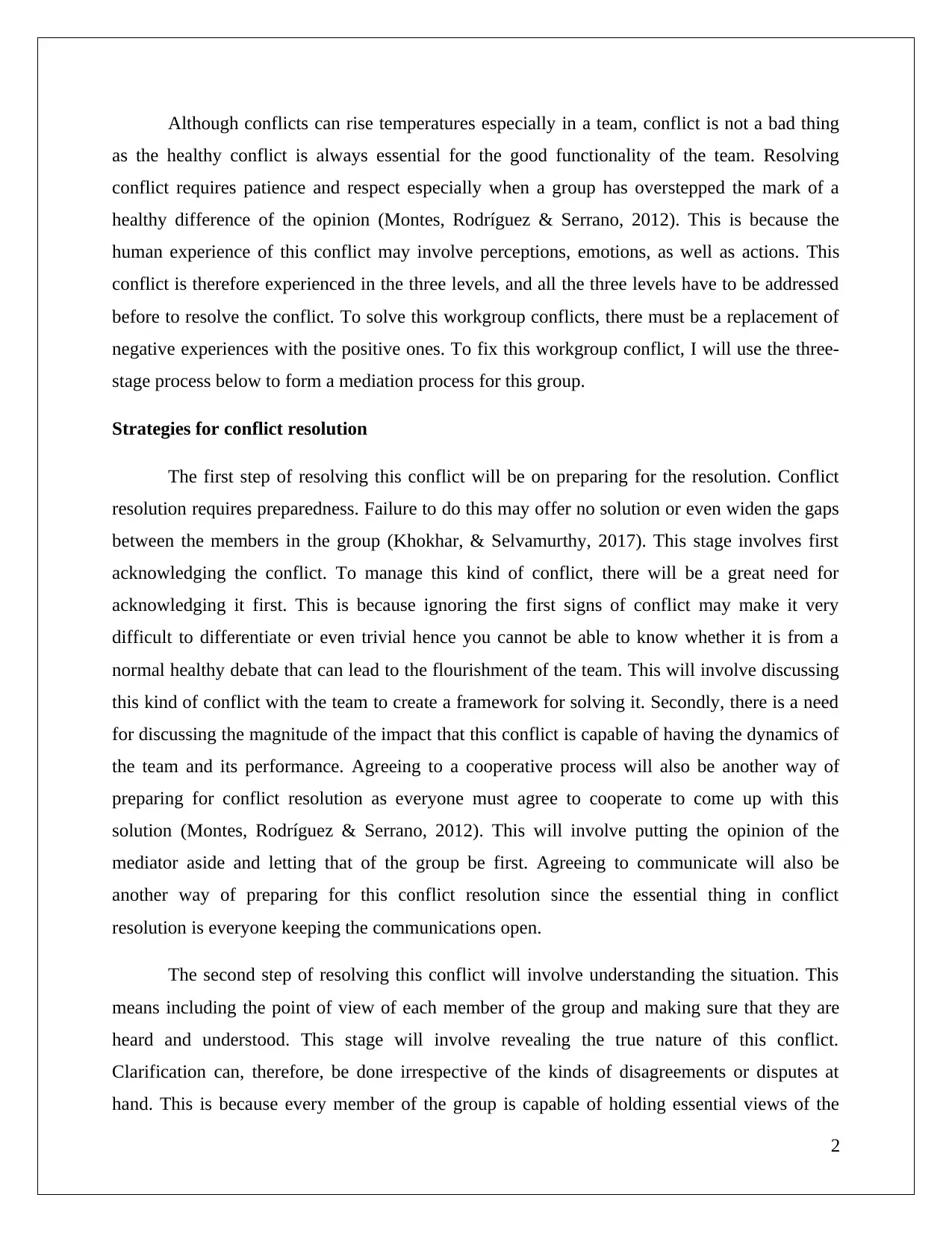
Although conflicts can rise temperatures especially in a team, conflict is not a bad thing
as the healthy conflict is always essential for the good functionality of the team. Resolving
conflict requires patience and respect especially when a group has overstepped the mark of a
healthy difference of the opinion (Montes, Rodríguez & Serrano, 2012). This is because the
human experience of this conflict may involve perceptions, emotions, as well as actions. This
conflict is therefore experienced in the three levels, and all the three levels have to be addressed
before to resolve the conflict. To solve this workgroup conflicts, there must be a replacement of
negative experiences with the positive ones. To fix this workgroup conflict, I will use the three-
stage process below to form a mediation process for this group.
Strategies for conflict resolution
The first step of resolving this conflict will be on preparing for the resolution. Conflict
resolution requires preparedness. Failure to do this may offer no solution or even widen the gaps
between the members in the group (Khokhar, & Selvamurthy, 2017). This stage involves first
acknowledging the conflict. To manage this kind of conflict, there will be a great need for
acknowledging it first. This is because ignoring the first signs of conflict may make it very
difficult to differentiate or even trivial hence you cannot be able to know whether it is from a
normal healthy debate that can lead to the flourishment of the team. This will involve discussing
this kind of conflict with the team to create a framework for solving it. Secondly, there is a need
for discussing the magnitude of the impact that this conflict is capable of having the dynamics of
the team and its performance. Agreeing to a cooperative process will also be another way of
preparing for conflict resolution as everyone must agree to cooperate to come up with this
solution (Montes, Rodríguez & Serrano, 2012). This will involve putting the opinion of the
mediator aside and letting that of the group be first. Agreeing to communicate will also be
another way of preparing for this conflict resolution since the essential thing in conflict
resolution is everyone keeping the communications open.
The second step of resolving this conflict will involve understanding the situation. This
means including the point of view of each member of the group and making sure that they are
heard and understood. This stage will involve revealing the true nature of this conflict.
Clarification can, therefore, be done irrespective of the kinds of disagreements or disputes at
hand. This is because every member of the group is capable of holding essential views of the
2
as the healthy conflict is always essential for the good functionality of the team. Resolving
conflict requires patience and respect especially when a group has overstepped the mark of a
healthy difference of the opinion (Montes, Rodríguez & Serrano, 2012). This is because the
human experience of this conflict may involve perceptions, emotions, as well as actions. This
conflict is therefore experienced in the three levels, and all the three levels have to be addressed
before to resolve the conflict. To solve this workgroup conflicts, there must be a replacement of
negative experiences with the positive ones. To fix this workgroup conflict, I will use the three-
stage process below to form a mediation process for this group.
Strategies for conflict resolution
The first step of resolving this conflict will be on preparing for the resolution. Conflict
resolution requires preparedness. Failure to do this may offer no solution or even widen the gaps
between the members in the group (Khokhar, & Selvamurthy, 2017). This stage involves first
acknowledging the conflict. To manage this kind of conflict, there will be a great need for
acknowledging it first. This is because ignoring the first signs of conflict may make it very
difficult to differentiate or even trivial hence you cannot be able to know whether it is from a
normal healthy debate that can lead to the flourishment of the team. This will involve discussing
this kind of conflict with the team to create a framework for solving it. Secondly, there is a need
for discussing the magnitude of the impact that this conflict is capable of having the dynamics of
the team and its performance. Agreeing to a cooperative process will also be another way of
preparing for conflict resolution as everyone must agree to cooperate to come up with this
solution (Montes, Rodríguez & Serrano, 2012). This will involve putting the opinion of the
mediator aside and letting that of the group be first. Agreeing to communicate will also be
another way of preparing for this conflict resolution since the essential thing in conflict
resolution is everyone keeping the communications open.
The second step of resolving this conflict will involve understanding the situation. This
means including the point of view of each member of the group and making sure that they are
heard and understood. This stage will involve revealing the true nature of this conflict.
Clarification can, therefore, be done irrespective of the kinds of disagreements or disputes at
hand. This is because every member of the group is capable of holding essential views of the
2
⊘ This is a preview!⊘
Do you want full access?
Subscribe today to unlock all pages.

Trusted by 1+ million students worldwide
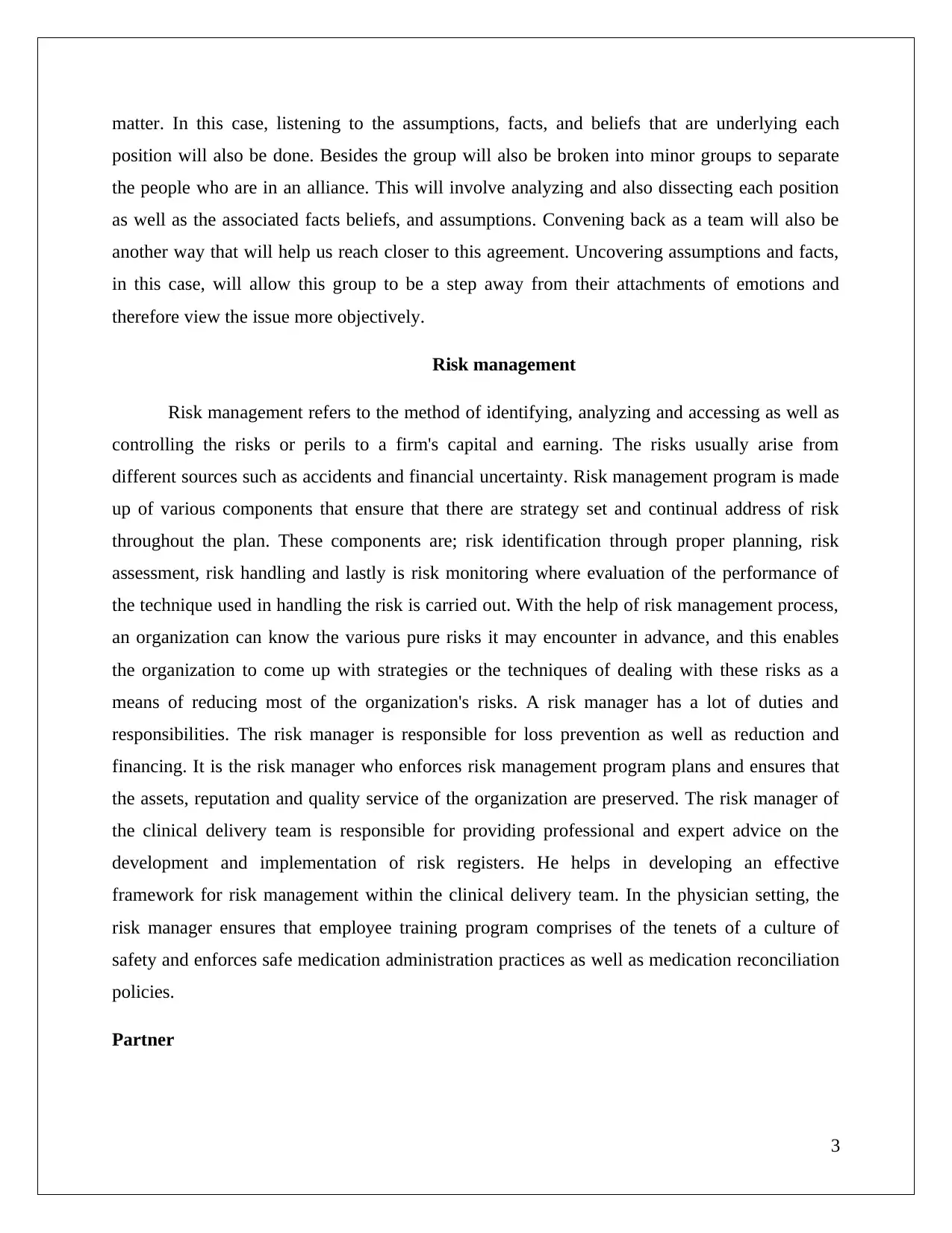
matter. In this case, listening to the assumptions, facts, and beliefs that are underlying each
position will also be done. Besides the group will also be broken into minor groups to separate
the people who are in an alliance. This will involve analyzing and also dissecting each position
as well as the associated facts beliefs, and assumptions. Convening back as a team will also be
another way that will help us reach closer to this agreement. Uncovering assumptions and facts,
in this case, will allow this group to be a step away from their attachments of emotions and
therefore view the issue more objectively.
Risk management
Risk management refers to the method of identifying, analyzing and accessing as well as
controlling the risks or perils to a firm's capital and earning. The risks usually arise from
different sources such as accidents and financial uncertainty. Risk management program is made
up of various components that ensure that there are strategy set and continual address of risk
throughout the plan. These components are; risk identification through proper planning, risk
assessment, risk handling and lastly is risk monitoring where evaluation of the performance of
the technique used in handling the risk is carried out. With the help of risk management process,
an organization can know the various pure risks it may encounter in advance, and this enables
the organization to come up with strategies or the techniques of dealing with these risks as a
means of reducing most of the organization's risks. A risk manager has a lot of duties and
responsibilities. The risk manager is responsible for loss prevention as well as reduction and
financing. It is the risk manager who enforces risk management program plans and ensures that
the assets, reputation and quality service of the organization are preserved. The risk manager of
the clinical delivery team is responsible for providing professional and expert advice on the
development and implementation of risk registers. He helps in developing an effective
framework for risk management within the clinical delivery team. In the physician setting, the
risk manager ensures that employee training program comprises of the tenets of a culture of
safety and enforces safe medication administration practices as well as medication reconciliation
policies.
Partner
3
position will also be done. Besides the group will also be broken into minor groups to separate
the people who are in an alliance. This will involve analyzing and also dissecting each position
as well as the associated facts beliefs, and assumptions. Convening back as a team will also be
another way that will help us reach closer to this agreement. Uncovering assumptions and facts,
in this case, will allow this group to be a step away from their attachments of emotions and
therefore view the issue more objectively.
Risk management
Risk management refers to the method of identifying, analyzing and accessing as well as
controlling the risks or perils to a firm's capital and earning. The risks usually arise from
different sources such as accidents and financial uncertainty. Risk management program is made
up of various components that ensure that there are strategy set and continual address of risk
throughout the plan. These components are; risk identification through proper planning, risk
assessment, risk handling and lastly is risk monitoring where evaluation of the performance of
the technique used in handling the risk is carried out. With the help of risk management process,
an organization can know the various pure risks it may encounter in advance, and this enables
the organization to come up with strategies or the techniques of dealing with these risks as a
means of reducing most of the organization's risks. A risk manager has a lot of duties and
responsibilities. The risk manager is responsible for loss prevention as well as reduction and
financing. It is the risk manager who enforces risk management program plans and ensures that
the assets, reputation and quality service of the organization are preserved. The risk manager of
the clinical delivery team is responsible for providing professional and expert advice on the
development and implementation of risk registers. He helps in developing an effective
framework for risk management within the clinical delivery team. In the physician setting, the
risk manager ensures that employee training program comprises of the tenets of a culture of
safety and enforces safe medication administration practices as well as medication reconciliation
policies.
Partner
3
Paraphrase This Document
Need a fresh take? Get an instant paraphrase of this document with our AI Paraphraser
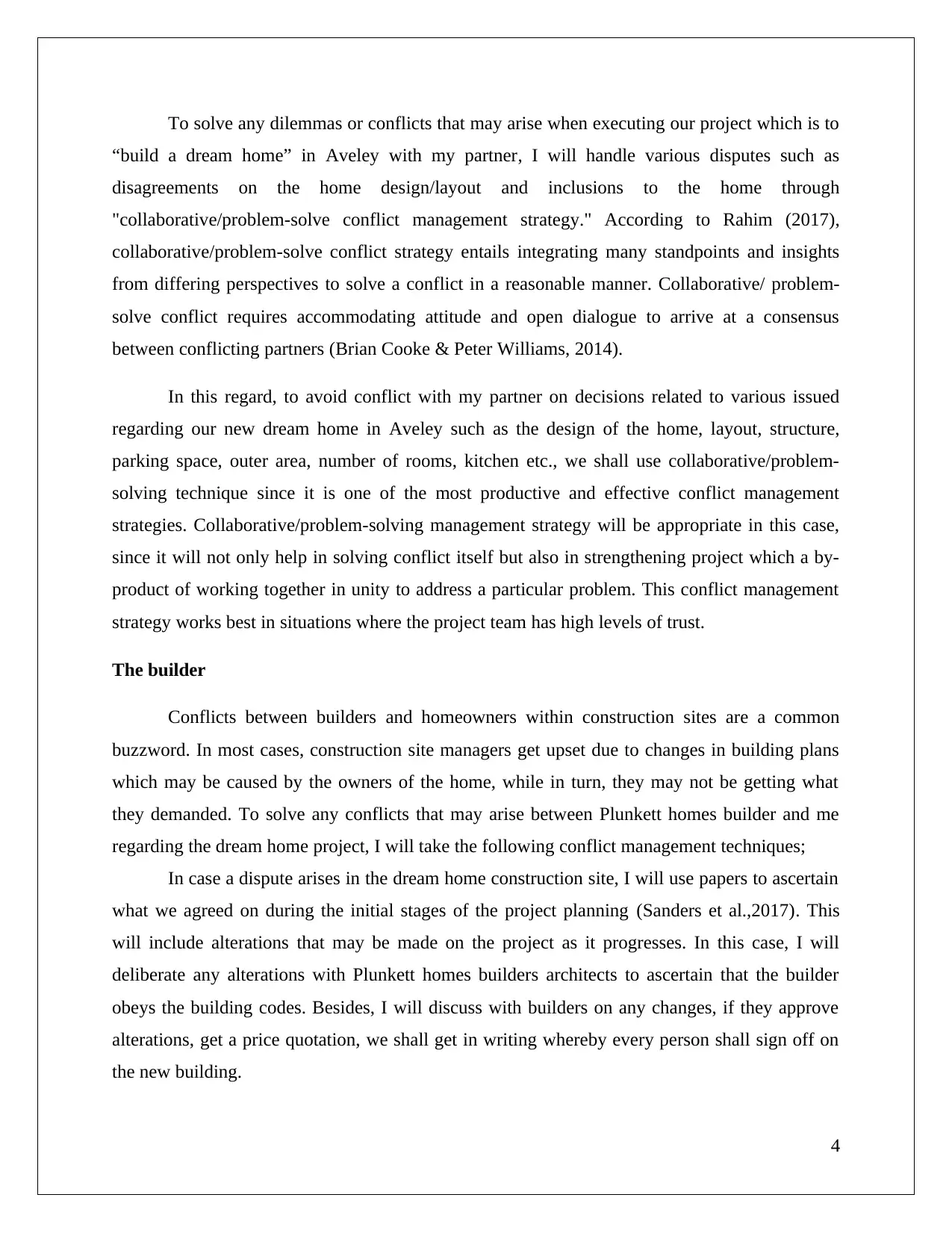
To solve any dilemmas or conflicts that may arise when executing our project which is to
“build a dream home” in Aveley with my partner, I will handle various disputes such as
disagreements on the home design/layout and inclusions to the home through
"collaborative/problem-solve conflict management strategy." According to Rahim (2017),
collaborative/problem-solve conflict strategy entails integrating many standpoints and insights
from differing perspectives to solve a conflict in a reasonable manner. Collaborative/ problem-
solve conflict requires accommodating attitude and open dialogue to arrive at a consensus
between conflicting partners (Brian Cooke & Peter Williams, 2014).
In this regard, to avoid conflict with my partner on decisions related to various issued
regarding our new dream home in Aveley such as the design of the home, layout, structure,
parking space, outer area, number of rooms, kitchen etc., we shall use collaborative/problem-
solving technique since it is one of the most productive and effective conflict management
strategies. Collaborative/problem-solving management strategy will be appropriate in this case,
since it will not only help in solving conflict itself but also in strengthening project which a by-
product of working together in unity to address a particular problem. This conflict management
strategy works best in situations where the project team has high levels of trust.
The builder
Conflicts between builders and homeowners within construction sites are a common
buzzword. In most cases, construction site managers get upset due to changes in building plans
which may be caused by the owners of the home, while in turn, they may not be getting what
they demanded. To solve any conflicts that may arise between Plunkett homes builder and me
regarding the dream home project, I will take the following conflict management techniques;
In case a dispute arises in the dream home construction site, I will use papers to ascertain
what we agreed on during the initial stages of the project planning (Sanders et al.,2017). This
will include alterations that may be made on the project as it progresses. In this case, I will
deliberate any alterations with Plunkett homes builders architects to ascertain that the builder
obeys the building codes. Besides, I will discuss with builders on any changes, if they approve
alterations, get a price quotation, we shall get in writing whereby every person shall sign off on
the new building.
4
“build a dream home” in Aveley with my partner, I will handle various disputes such as
disagreements on the home design/layout and inclusions to the home through
"collaborative/problem-solve conflict management strategy." According to Rahim (2017),
collaborative/problem-solve conflict strategy entails integrating many standpoints and insights
from differing perspectives to solve a conflict in a reasonable manner. Collaborative/ problem-
solve conflict requires accommodating attitude and open dialogue to arrive at a consensus
between conflicting partners (Brian Cooke & Peter Williams, 2014).
In this regard, to avoid conflict with my partner on decisions related to various issued
regarding our new dream home in Aveley such as the design of the home, layout, structure,
parking space, outer area, number of rooms, kitchen etc., we shall use collaborative/problem-
solving technique since it is one of the most productive and effective conflict management
strategies. Collaborative/problem-solving management strategy will be appropriate in this case,
since it will not only help in solving conflict itself but also in strengthening project which a by-
product of working together in unity to address a particular problem. This conflict management
strategy works best in situations where the project team has high levels of trust.
The builder
Conflicts between builders and homeowners within construction sites are a common
buzzword. In most cases, construction site managers get upset due to changes in building plans
which may be caused by the owners of the home, while in turn, they may not be getting what
they demanded. To solve any conflicts that may arise between Plunkett homes builder and me
regarding the dream home project, I will take the following conflict management techniques;
In case a dispute arises in the dream home construction site, I will use papers to ascertain
what we agreed on during the initial stages of the project planning (Sanders et al.,2017). This
will include alterations that may be made on the project as it progresses. In this case, I will
deliberate any alterations with Plunkett homes builders architects to ascertain that the builder
obeys the building codes. Besides, I will discuss with builders on any changes, if they approve
alterations, get a price quotation, we shall get in writing whereby every person shall sign off on
the new building.
4
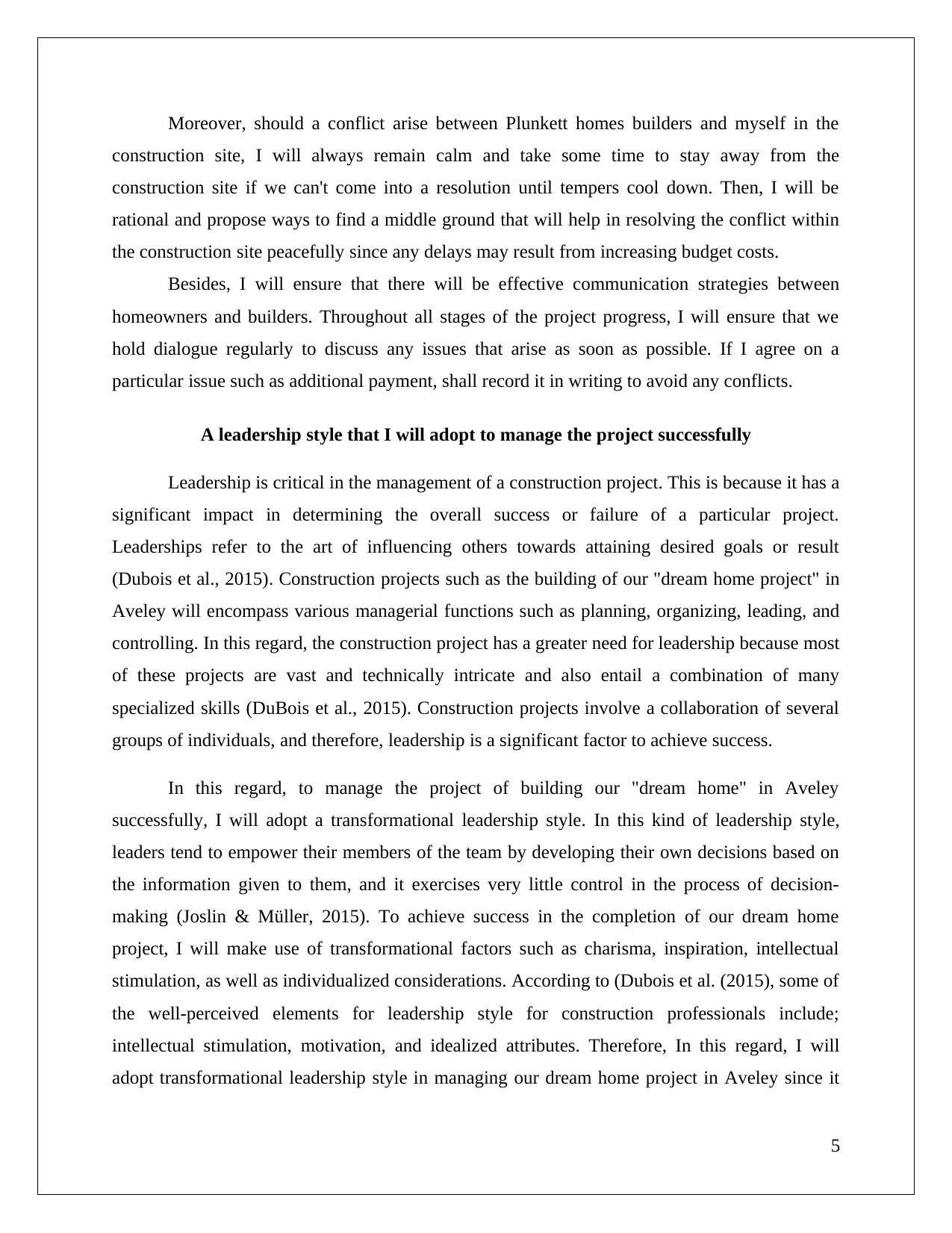
Moreover, should a conflict arise between Plunkett homes builders and myself in the
construction site, I will always remain calm and take some time to stay away from the
construction site if we can't come into a resolution until tempers cool down. Then, I will be
rational and propose ways to find a middle ground that will help in resolving the conflict within
the construction site peacefully since any delays may result from increasing budget costs.
Besides, I will ensure that there will be effective communication strategies between
homeowners and builders. Throughout all stages of the project progress, I will ensure that we
hold dialogue regularly to discuss any issues that arise as soon as possible. If I agree on a
particular issue such as additional payment, shall record it in writing to avoid any conflicts.
A leadership style that I will adopt to manage the project successfully
Leadership is critical in the management of a construction project. This is because it has a
significant impact in determining the overall success or failure of a particular project.
Leaderships refer to the art of influencing others towards attaining desired goals or result
(Dubois et al., 2015). Construction projects such as the building of our "dream home project" in
Aveley will encompass various managerial functions such as planning, organizing, leading, and
controlling. In this regard, the construction project has a greater need for leadership because most
of these projects are vast and technically intricate and also entail a combination of many
specialized skills (DuBois et al., 2015). Construction projects involve a collaboration of several
groups of individuals, and therefore, leadership is a significant factor to achieve success.
In this regard, to manage the project of building our "dream home" in Aveley
successfully, I will adopt a transformational leadership style. In this kind of leadership style,
leaders tend to empower their members of the team by developing their own decisions based on
the information given to them, and it exercises very little control in the process of decision-
making (Joslin & Müller, 2015). To achieve success in the completion of our dream home
project, I will make use of transformational factors such as charisma, inspiration, intellectual
stimulation, as well as individualized considerations. According to (Dubois et al. (2015), some of
the well-perceived elements for leadership style for construction professionals include;
intellectual stimulation, motivation, and idealized attributes. Therefore, In this regard, I will
adopt transformational leadership style in managing our dream home project in Aveley since it
5
construction site, I will always remain calm and take some time to stay away from the
construction site if we can't come into a resolution until tempers cool down. Then, I will be
rational and propose ways to find a middle ground that will help in resolving the conflict within
the construction site peacefully since any delays may result from increasing budget costs.
Besides, I will ensure that there will be effective communication strategies between
homeowners and builders. Throughout all stages of the project progress, I will ensure that we
hold dialogue regularly to discuss any issues that arise as soon as possible. If I agree on a
particular issue such as additional payment, shall record it in writing to avoid any conflicts.
A leadership style that I will adopt to manage the project successfully
Leadership is critical in the management of a construction project. This is because it has a
significant impact in determining the overall success or failure of a particular project.
Leaderships refer to the art of influencing others towards attaining desired goals or result
(Dubois et al., 2015). Construction projects such as the building of our "dream home project" in
Aveley will encompass various managerial functions such as planning, organizing, leading, and
controlling. In this regard, the construction project has a greater need for leadership because most
of these projects are vast and technically intricate and also entail a combination of many
specialized skills (DuBois et al., 2015). Construction projects involve a collaboration of several
groups of individuals, and therefore, leadership is a significant factor to achieve success.
In this regard, to manage the project of building our "dream home" in Aveley
successfully, I will adopt a transformational leadership style. In this kind of leadership style,
leaders tend to empower their members of the team by developing their own decisions based on
the information given to them, and it exercises very little control in the process of decision-
making (Joslin & Müller, 2015). To achieve success in the completion of our dream home
project, I will make use of transformational factors such as charisma, inspiration, intellectual
stimulation, as well as individualized considerations. According to (Dubois et al. (2015), some of
the well-perceived elements for leadership style for construction professionals include;
intellectual stimulation, motivation, and idealized attributes. Therefore, In this regard, I will
adopt transformational leadership style in managing our dream home project in Aveley since it
5
⊘ This is a preview!⊘
Do you want full access?
Subscribe today to unlock all pages.

Trusted by 1+ million students worldwide
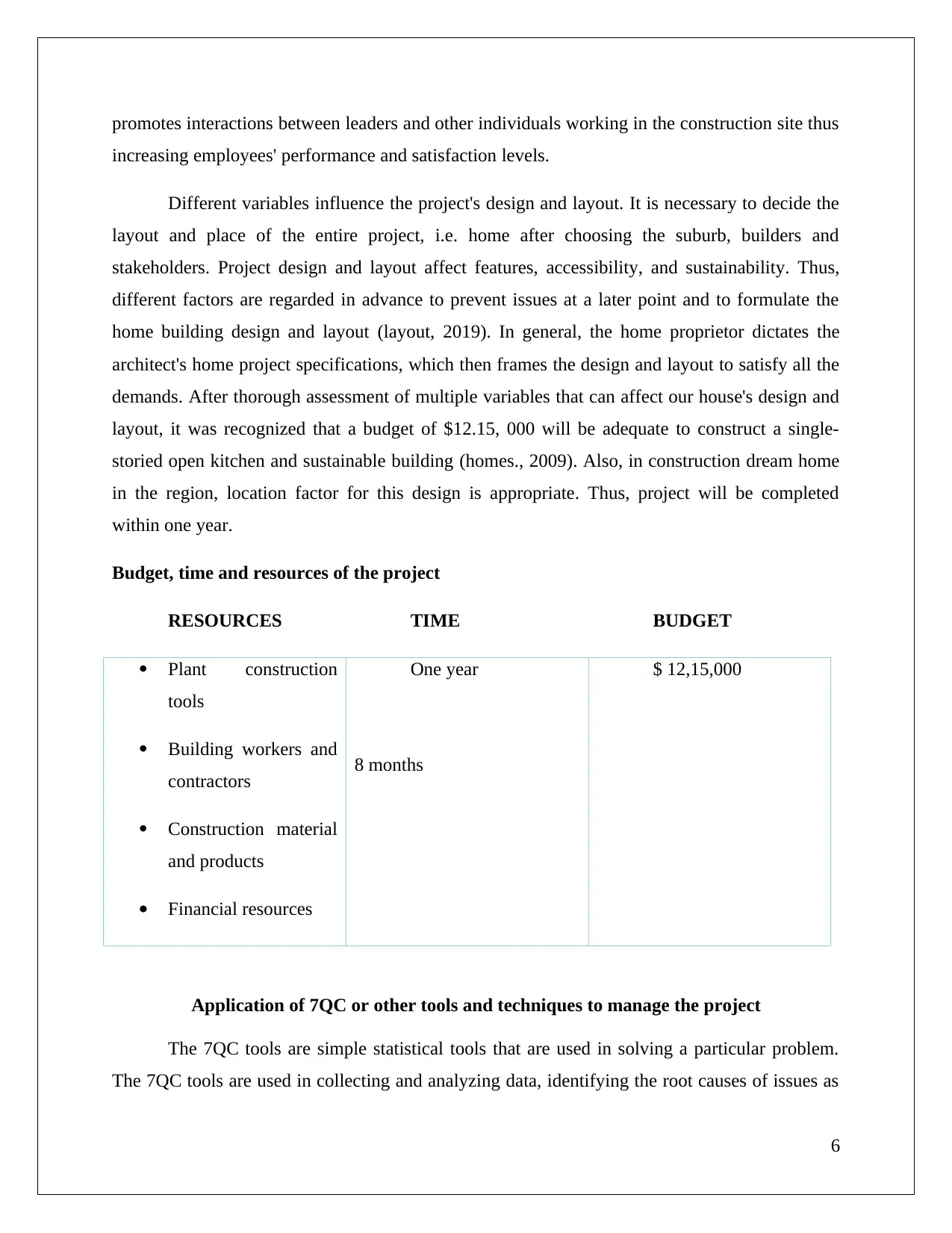
promotes interactions between leaders and other individuals working in the construction site thus
increasing employees' performance and satisfaction levels.
Different variables influence the project's design and layout. It is necessary to decide the
layout and place of the entire project, i.e. home after choosing the suburb, builders and
stakeholders. Project design and layout affect features, accessibility, and sustainability. Thus,
different factors are regarded in advance to prevent issues at a later point and to formulate the
home building design and layout (layout, 2019). In general, the home proprietor dictates the
architect's home project specifications, which then frames the design and layout to satisfy all the
demands. After thorough assessment of multiple variables that can affect our house's design and
layout, it was recognized that a budget of $12.15, 000 will be adequate to construct a single-
storied open kitchen and sustainable building (homes., 2009). Also, in construction dream home
in the region, location factor for this design is appropriate. Thus, project will be completed
within one year.
Budget, time and resources of the project
RESOURCES TIME BUDGET
Plant construction
tools
Building workers and
contractors
Construction material
and products
Financial resources
One year
8 months
$ 12,15,000
Application of 7QC or other tools and techniques to manage the project
The 7QC tools are simple statistical tools that are used in solving a particular problem.
The 7QC tools are used in collecting and analyzing data, identifying the root causes of issues as
6
increasing employees' performance and satisfaction levels.
Different variables influence the project's design and layout. It is necessary to decide the
layout and place of the entire project, i.e. home after choosing the suburb, builders and
stakeholders. Project design and layout affect features, accessibility, and sustainability. Thus,
different factors are regarded in advance to prevent issues at a later point and to formulate the
home building design and layout (layout, 2019). In general, the home proprietor dictates the
architect's home project specifications, which then frames the design and layout to satisfy all the
demands. After thorough assessment of multiple variables that can affect our house's design and
layout, it was recognized that a budget of $12.15, 000 will be adequate to construct a single-
storied open kitchen and sustainable building (homes., 2009). Also, in construction dream home
in the region, location factor for this design is appropriate. Thus, project will be completed
within one year.
Budget, time and resources of the project
RESOURCES TIME BUDGET
Plant construction
tools
Building workers and
contractors
Construction material
and products
Financial resources
One year
8 months
$ 12,15,000
Application of 7QC or other tools and techniques to manage the project
The 7QC tools are simple statistical tools that are used in solving a particular problem.
The 7QC tools are used in collecting and analyzing data, identifying the root causes of issues as
6
Paraphrase This Document
Need a fresh take? Get an instant paraphrase of this document with our AI Paraphraser
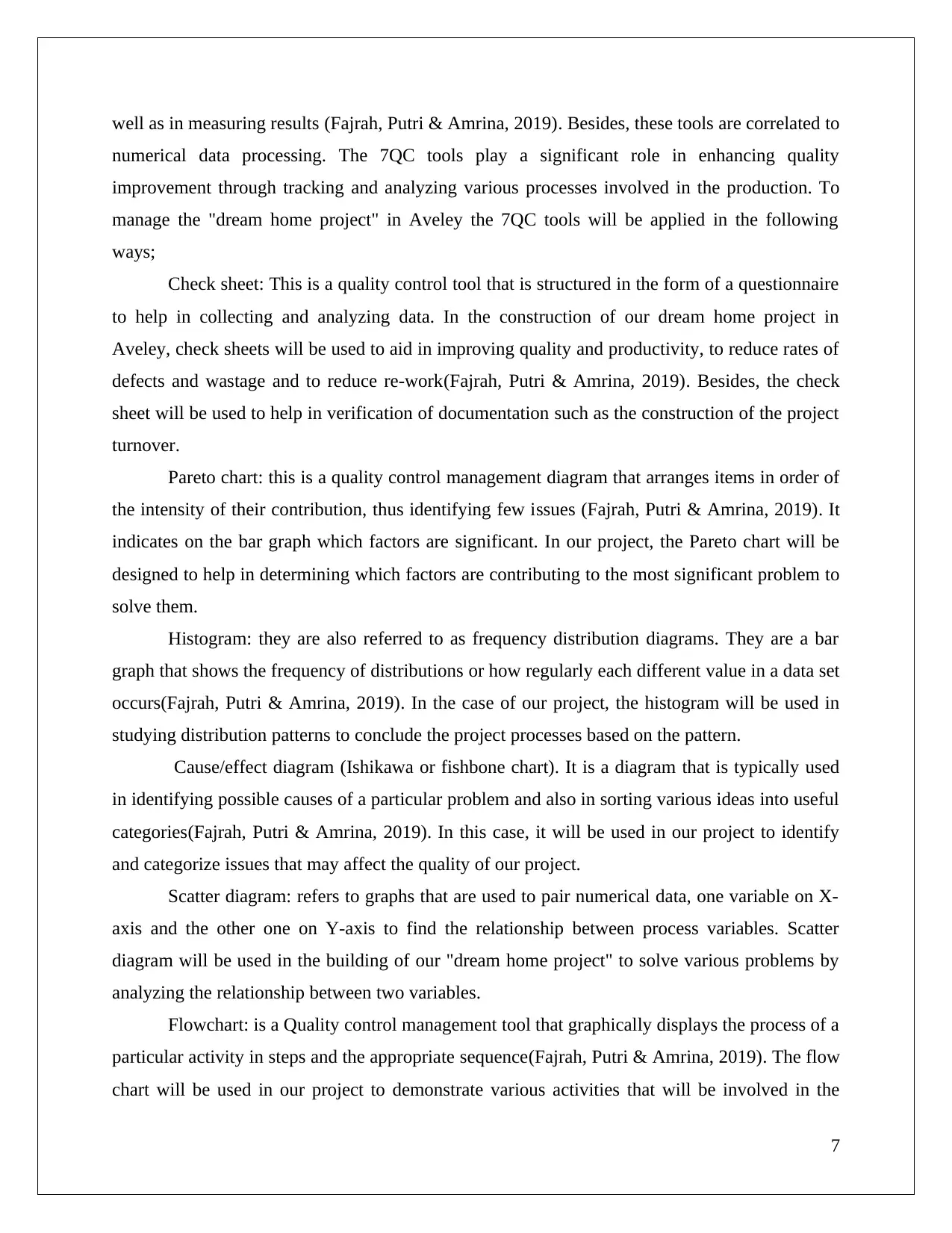
well as in measuring results (Fajrah, Putri & Amrina, 2019). Besides, these tools are correlated to
numerical data processing. The 7QC tools play a significant role in enhancing quality
improvement through tracking and analyzing various processes involved in the production. To
manage the "dream home project" in Aveley the 7QC tools will be applied in the following
ways;
Check sheet: This is a quality control tool that is structured in the form of a questionnaire
to help in collecting and analyzing data. In the construction of our dream home project in
Aveley, check sheets will be used to aid in improving quality and productivity, to reduce rates of
defects and wastage and to reduce re-work(Fajrah, Putri & Amrina, 2019). Besides, the check
sheet will be used to help in verification of documentation such as the construction of the project
turnover.
Pareto chart: this is a quality control management diagram that arranges items in order of
the intensity of their contribution, thus identifying few issues (Fajrah, Putri & Amrina, 2019). It
indicates on the bar graph which factors are significant. In our project, the Pareto chart will be
designed to help in determining which factors are contributing to the most significant problem to
solve them.
Histogram: they are also referred to as frequency distribution diagrams. They are a bar
graph that shows the frequency of distributions or how regularly each different value in a data set
occurs(Fajrah, Putri & Amrina, 2019). In the case of our project, the histogram will be used in
studying distribution patterns to conclude the project processes based on the pattern.
Cause/effect diagram (Ishikawa or fishbone chart). It is a diagram that is typically used
in identifying possible causes of a particular problem and also in sorting various ideas into useful
categories(Fajrah, Putri & Amrina, 2019). In this case, it will be used in our project to identify
and categorize issues that may affect the quality of our project.
Scatter diagram: refers to graphs that are used to pair numerical data, one variable on X-
axis and the other one on Y-axis to find the relationship between process variables. Scatter
diagram will be used in the building of our "dream home project" to solve various problems by
analyzing the relationship between two variables.
Flowchart: is a Quality control management tool that graphically displays the process of a
particular activity in steps and the appropriate sequence(Fajrah, Putri & Amrina, 2019). The flow
chart will be used in our project to demonstrate various activities that will be involved in the
7
numerical data processing. The 7QC tools play a significant role in enhancing quality
improvement through tracking and analyzing various processes involved in the production. To
manage the "dream home project" in Aveley the 7QC tools will be applied in the following
ways;
Check sheet: This is a quality control tool that is structured in the form of a questionnaire
to help in collecting and analyzing data. In the construction of our dream home project in
Aveley, check sheets will be used to aid in improving quality and productivity, to reduce rates of
defects and wastage and to reduce re-work(Fajrah, Putri & Amrina, 2019). Besides, the check
sheet will be used to help in verification of documentation such as the construction of the project
turnover.
Pareto chart: this is a quality control management diagram that arranges items in order of
the intensity of their contribution, thus identifying few issues (Fajrah, Putri & Amrina, 2019). It
indicates on the bar graph which factors are significant. In our project, the Pareto chart will be
designed to help in determining which factors are contributing to the most significant problem to
solve them.
Histogram: they are also referred to as frequency distribution diagrams. They are a bar
graph that shows the frequency of distributions or how regularly each different value in a data set
occurs(Fajrah, Putri & Amrina, 2019). In the case of our project, the histogram will be used in
studying distribution patterns to conclude the project processes based on the pattern.
Cause/effect diagram (Ishikawa or fishbone chart). It is a diagram that is typically used
in identifying possible causes of a particular problem and also in sorting various ideas into useful
categories(Fajrah, Putri & Amrina, 2019). In this case, it will be used in our project to identify
and categorize issues that may affect the quality of our project.
Scatter diagram: refers to graphs that are used to pair numerical data, one variable on X-
axis and the other one on Y-axis to find the relationship between process variables. Scatter
diagram will be used in the building of our "dream home project" to solve various problems by
analyzing the relationship between two variables.
Flowchart: is a Quality control management tool that graphically displays the process of a
particular activity in steps and the appropriate sequence(Fajrah, Putri & Amrina, 2019). The flow
chart will be used in our project to demonstrate various activities that will be involved in the
7
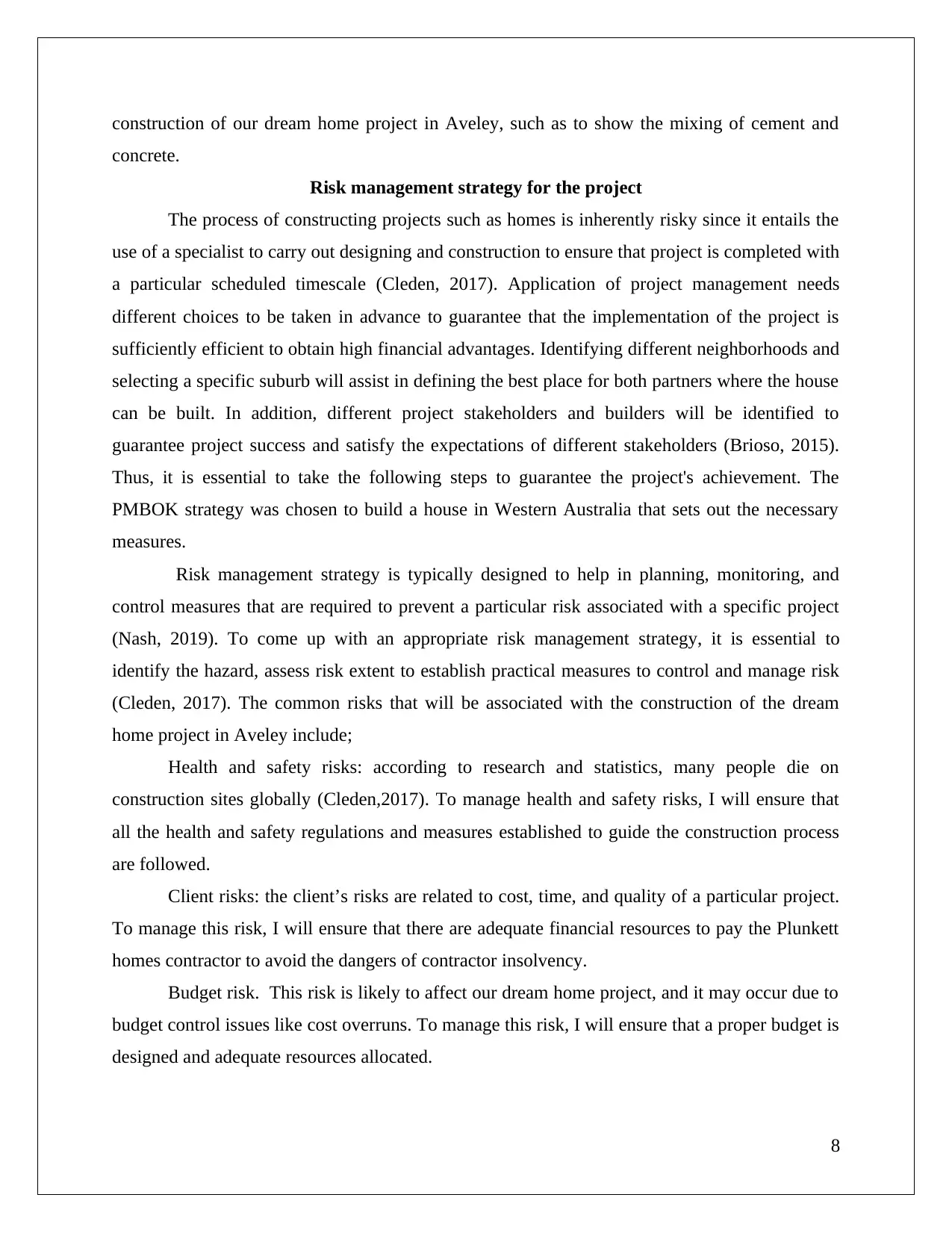
construction of our dream home project in Aveley, such as to show the mixing of cement and
concrete.
Risk management strategy for the project
The process of constructing projects such as homes is inherently risky since it entails the
use of a specialist to carry out designing and construction to ensure that project is completed with
a particular scheduled timescale (Cleden, 2017). Application of project management needs
different choices to be taken in advance to guarantee that the implementation of the project is
sufficiently efficient to obtain high financial advantages. Identifying different neighborhoods and
selecting a specific suburb will assist in defining the best place for both partners where the house
can be built. In addition, different project stakeholders and builders will be identified to
guarantee project success and satisfy the expectations of different stakeholders (Brioso, 2015).
Thus, it is essential to take the following steps to guarantee the project's achievement. The
PMBOK strategy was chosen to build a house in Western Australia that sets out the necessary
measures.
Risk management strategy is typically designed to help in planning, monitoring, and
control measures that are required to prevent a particular risk associated with a specific project
(Nash, 2019). To come up with an appropriate risk management strategy, it is essential to
identify the hazard, assess risk extent to establish practical measures to control and manage risk
(Cleden, 2017). The common risks that will be associated with the construction of the dream
home project in Aveley include;
Health and safety risks: according to research and statistics, many people die on
construction sites globally (Cleden,2017). To manage health and safety risks, I will ensure that
all the health and safety regulations and measures established to guide the construction process
are followed.
Client risks: the client’s risks are related to cost, time, and quality of a particular project.
To manage this risk, I will ensure that there are adequate financial resources to pay the Plunkett
homes contractor to avoid the dangers of contractor insolvency.
Budget risk. This risk is likely to affect our dream home project, and it may occur due to
budget control issues like cost overruns. To manage this risk, I will ensure that a proper budget is
designed and adequate resources allocated.
8
concrete.
Risk management strategy for the project
The process of constructing projects such as homes is inherently risky since it entails the
use of a specialist to carry out designing and construction to ensure that project is completed with
a particular scheduled timescale (Cleden, 2017). Application of project management needs
different choices to be taken in advance to guarantee that the implementation of the project is
sufficiently efficient to obtain high financial advantages. Identifying different neighborhoods and
selecting a specific suburb will assist in defining the best place for both partners where the house
can be built. In addition, different project stakeholders and builders will be identified to
guarantee project success and satisfy the expectations of different stakeholders (Brioso, 2015).
Thus, it is essential to take the following steps to guarantee the project's achievement. The
PMBOK strategy was chosen to build a house in Western Australia that sets out the necessary
measures.
Risk management strategy is typically designed to help in planning, monitoring, and
control measures that are required to prevent a particular risk associated with a specific project
(Nash, 2019). To come up with an appropriate risk management strategy, it is essential to
identify the hazard, assess risk extent to establish practical measures to control and manage risk
(Cleden, 2017). The common risks that will be associated with the construction of the dream
home project in Aveley include;
Health and safety risks: according to research and statistics, many people die on
construction sites globally (Cleden,2017). To manage health and safety risks, I will ensure that
all the health and safety regulations and measures established to guide the construction process
are followed.
Client risks: the client’s risks are related to cost, time, and quality of a particular project.
To manage this risk, I will ensure that there are adequate financial resources to pay the Plunkett
homes contractor to avoid the dangers of contractor insolvency.
Budget risk. This risk is likely to affect our dream home project, and it may occur due to
budget control issues like cost overruns. To manage this risk, I will ensure that a proper budget is
designed and adequate resources allocated.
8
⊘ This is a preview!⊘
Do you want full access?
Subscribe today to unlock all pages.

Trusted by 1+ million students worldwide
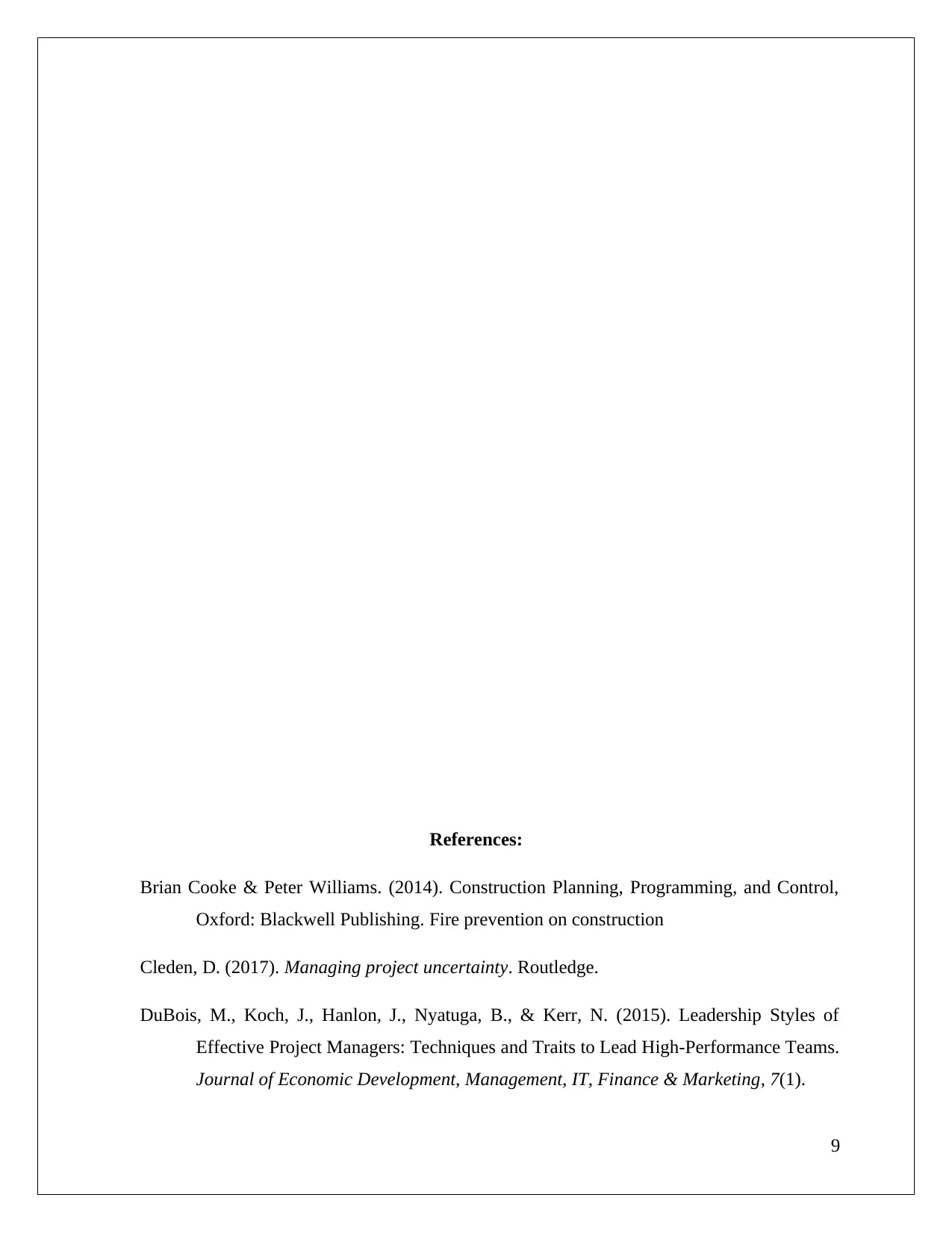
References:
Brian Cooke & Peter Williams. (2014). Construction Planning, Programming, and Control,
Oxford: Blackwell Publishing. Fire prevention on construction
Cleden, D. (2017). Managing project uncertainty. Routledge.
DuBois, M., Koch, J., Hanlon, J., Nyatuga, B., & Kerr, N. (2015). Leadership Styles of
Effective Project Managers: Techniques and Traits to Lead High-Performance Teams.
Journal of Economic Development, Management, IT, Finance & Marketing, 7(1).
9
Brian Cooke & Peter Williams. (2014). Construction Planning, Programming, and Control,
Oxford: Blackwell Publishing. Fire prevention on construction
Cleden, D. (2017). Managing project uncertainty. Routledge.
DuBois, M., Koch, J., Hanlon, J., Nyatuga, B., & Kerr, N. (2015). Leadership Styles of
Effective Project Managers: Techniques and Traits to Lead High-Performance Teams.
Journal of Economic Development, Management, IT, Finance & Marketing, 7(1).
9
Paraphrase This Document
Need a fresh take? Get an instant paraphrase of this document with our AI Paraphraser
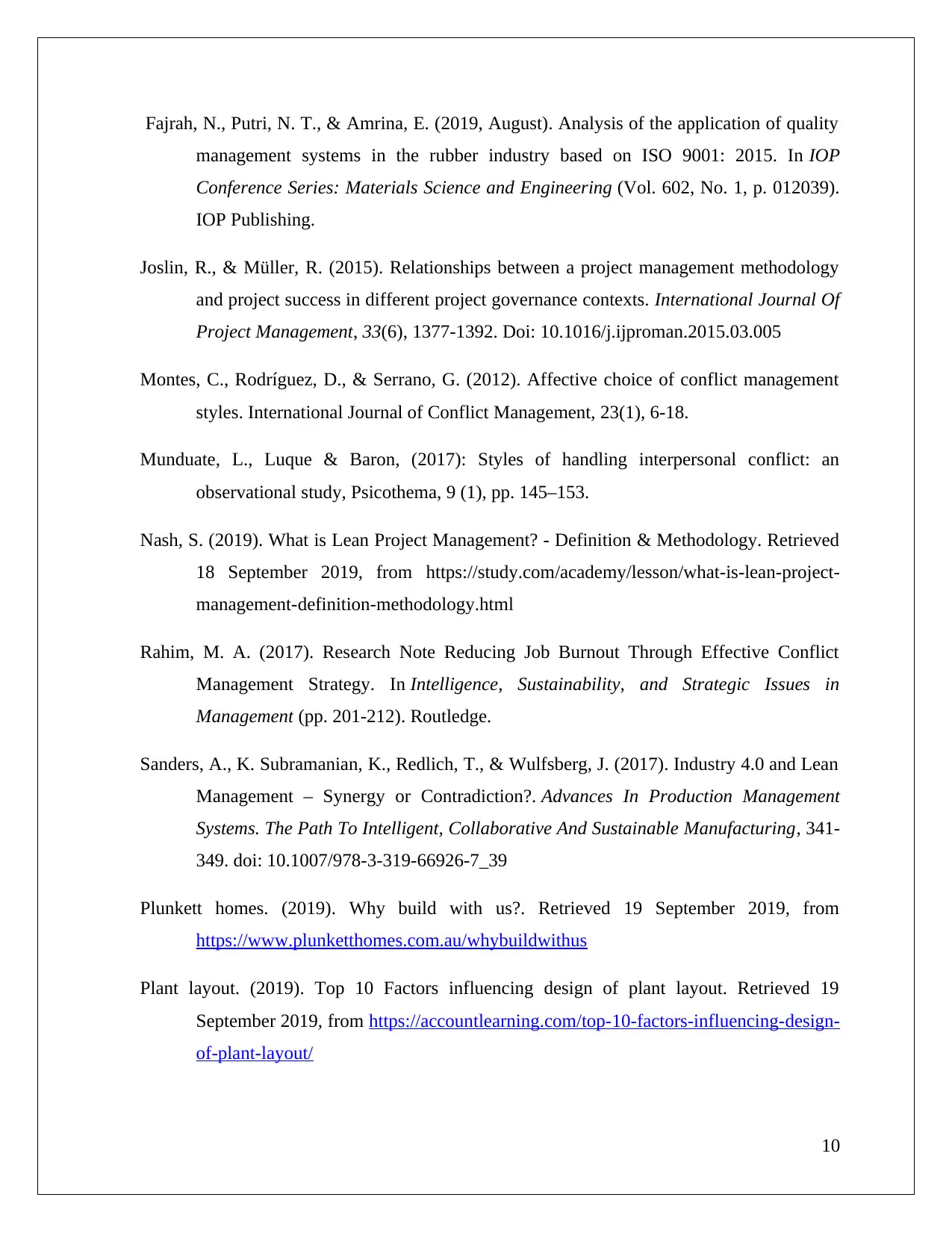
Fajrah, N., Putri, N. T., & Amrina, E. (2019, August). Analysis of the application of quality
management systems in the rubber industry based on ISO 9001: 2015. In IOP
Conference Series: Materials Science and Engineering (Vol. 602, No. 1, p. 012039).
IOP Publishing.
Joslin, R., & Müller, R. (2015). Relationships between a project management methodology
and project success in different project governance contexts. International Journal Of
Project Management, 33(6), 1377-1392. Doi: 10.1016/j.ijproman.2015.03.005
Montes, C., Rodríguez, D., & Serrano, G. (2012). Affective choice of conflict management
styles. International Journal of Conflict Management, 23(1), 6-18.
Munduate, L., Luque & Baron, (2017): Styles of handling interpersonal conflict: an
observational study, Psicothema, 9 (1), pp. 145–153.
Nash, S. (2019). What is Lean Project Management? - Definition & Methodology. Retrieved
18 September 2019, from https://study.com/academy/lesson/what-is-lean-project-
management-definition-methodology.html
Rahim, M. A. (2017). Research Note Reducing Job Burnout Through Effective Conflict
Management Strategy. In Intelligence, Sustainability, and Strategic Issues in
Management (pp. 201-212). Routledge.
Sanders, A., K. Subramanian, K., Redlich, T., & Wulfsberg, J. (2017). Industry 4.0 and Lean
Management – Synergy or Contradiction?. Advances In Production Management
Systems. The Path To Intelligent, Collaborative And Sustainable Manufacturing, 341-
349. doi: 10.1007/978-3-319-66926-7_39
Plunkett homes. (2019). Why build with us?. Retrieved 19 September 2019, from
https://www.plunketthomes.com.au/whybuildwithus
Plant layout. (2019). Top 10 Factors influencing design of plant layout. Retrieved 19
September 2019, from https://accountlearning.com/top-10-factors-influencing-design-
of-plant-layout/
10
management systems in the rubber industry based on ISO 9001: 2015. In IOP
Conference Series: Materials Science and Engineering (Vol. 602, No. 1, p. 012039).
IOP Publishing.
Joslin, R., & Müller, R. (2015). Relationships between a project management methodology
and project success in different project governance contexts. International Journal Of
Project Management, 33(6), 1377-1392. Doi: 10.1016/j.ijproman.2015.03.005
Montes, C., Rodríguez, D., & Serrano, G. (2012). Affective choice of conflict management
styles. International Journal of Conflict Management, 23(1), 6-18.
Munduate, L., Luque & Baron, (2017): Styles of handling interpersonal conflict: an
observational study, Psicothema, 9 (1), pp. 145–153.
Nash, S. (2019). What is Lean Project Management? - Definition & Methodology. Retrieved
18 September 2019, from https://study.com/academy/lesson/what-is-lean-project-
management-definition-methodology.html
Rahim, M. A. (2017). Research Note Reducing Job Burnout Through Effective Conflict
Management Strategy. In Intelligence, Sustainability, and Strategic Issues in
Management (pp. 201-212). Routledge.
Sanders, A., K. Subramanian, K., Redlich, T., & Wulfsberg, J. (2017). Industry 4.0 and Lean
Management – Synergy or Contradiction?. Advances In Production Management
Systems. The Path To Intelligent, Collaborative And Sustainable Manufacturing, 341-
349. doi: 10.1007/978-3-319-66926-7_39
Plunkett homes. (2019). Why build with us?. Retrieved 19 September 2019, from
https://www.plunketthomes.com.au/whybuildwithus
Plant layout. (2019). Top 10 Factors influencing design of plant layout. Retrieved 19
September 2019, from https://accountlearning.com/top-10-factors-influencing-design-
of-plant-layout/
10
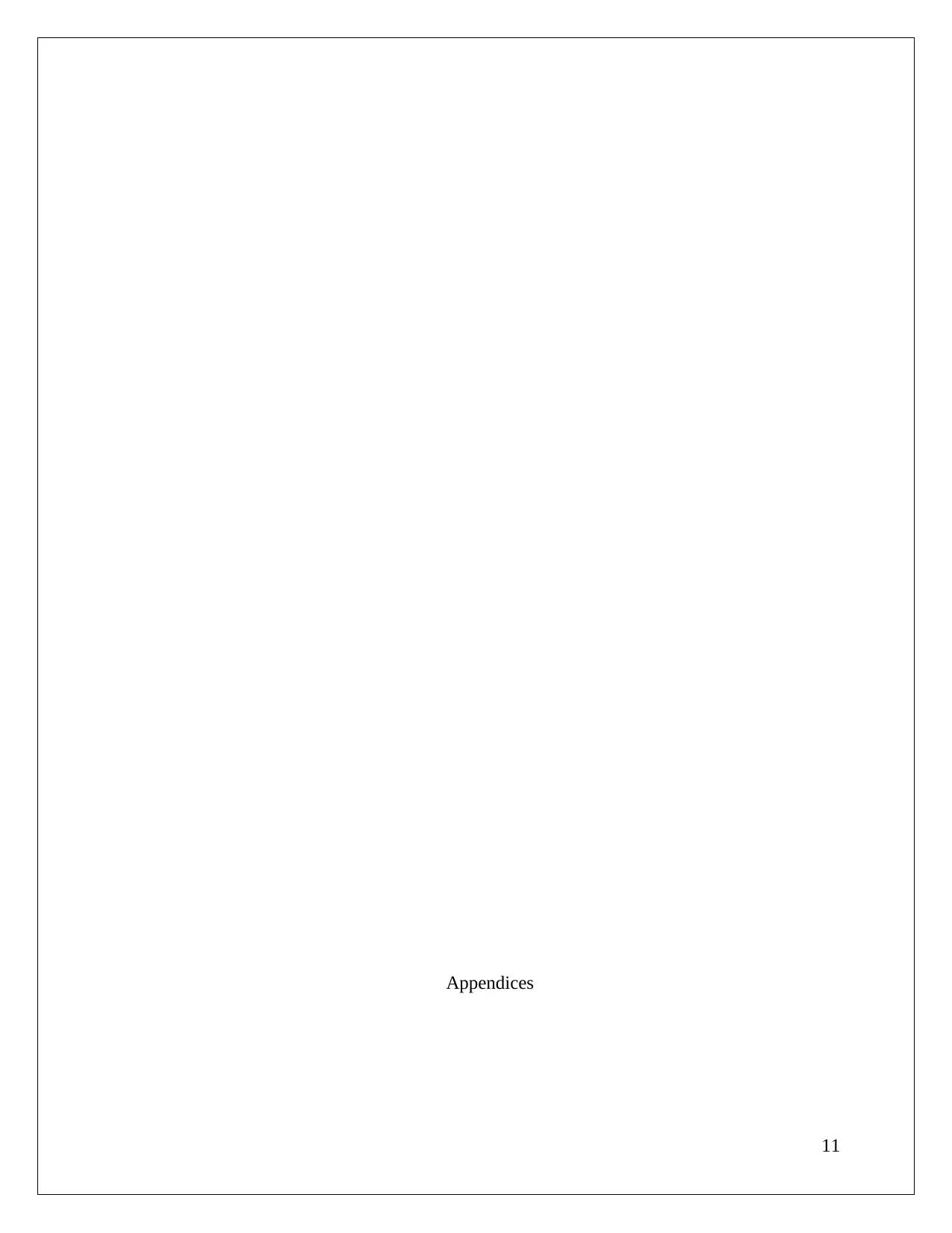
Appendices
11
11
⊘ This is a preview!⊘
Do you want full access?
Subscribe today to unlock all pages.

Trusted by 1+ million students worldwide
1 out of 13
Related Documents
Your All-in-One AI-Powered Toolkit for Academic Success.
+13062052269
info@desklib.com
Available 24*7 on WhatsApp / Email
![[object Object]](/_next/static/media/star-bottom.7253800d.svg)
Unlock your academic potential
Copyright © 2020–2025 A2Z Services. All Rights Reserved. Developed and managed by ZUCOL.





